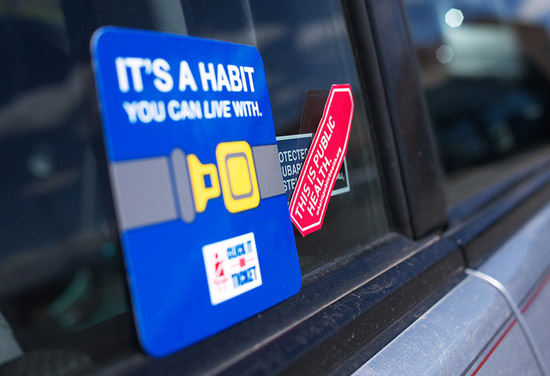
Seat belts and exercise have one thing in common—the ability to prevent injury and illness. Photo: Alamosa County Public Health
Can you really “prevent” cancer? This is a question The Maurer Foundation gets often, and for a good reason. Breast cancer prevention lies at the heart of our non-profit mission and is the primary goal of our youth, community, and corporate breast health education programs. We often use the motto “Stop breast cancer before it starts.” We believe that until a cure is developed, cancer prevention methods offer the most accessible and actionable ways that people can reduce their risk of being diagnosed.
The phrase “cancer prevention” is typically applied as a statistical term to a group of people, but it can also be applied to one person. The National Cancer Institute defines “cancer prevention” as “action taken to lower the chance of getting cancer.” It is important to note that complete and guaranteed protection from cancer is not necessary to be classified as a “cancer prevention” action.
Unfortunately, “cancer prevention” methods cannot prevent cancer 100% of the time. We agree with the American Cancer Society which states, “there is no sure way to prevent breast cancer.” Every person’s risk level is unique and based on a multitude of risk factorsAnything that increases or decreases a person’s chance of developing a disease., some of which we do not completely understand.
Similarly, although wearing a seat belt will not prevent car accident injuries every time, most people would agree that wearing seat belts saves lives and prevents injuries. We believe cancer is the same. There is much we do know about cancer, including some of the ways to reduce the number of cases diagnosed.
According to the World Health Organization (WHO), “At least one-third of all cancer cases are preventable. Prevention offers the most cost-effective long-term strategy for the control of cancer.” And according to the National Cancer Institute: “Scientists estimate that as many as 50–75 percent of cancer deaths in the United States are caused by human behaviors such as smoking, poor diet quality, and physical inactivity.”
- Smoking is the the cause of about 30% of U.S. cancer deaths
- An estimated 14% of male and 20% of female U.S. cancer deaths are related to poor nutrition, lack of exercise, obesity or a combination of these.
Lifestyle changes like increasing physical activity and reducing tobacco use are cancer’s metaphorical seat belts—not guaranteed to prevent injury or illness 100% of the time, but these actions can make a big difference in your health most of the time. And like the seat belt’s effect on car injury rates, these lifestyle changes have proven in study after study to decrease cancer rates.
Each of us will never know the injuries we might have received had we not been wearing a seat belt in any specific car accident. And each of us will never know if that 15-mile per week running habit was the reason we didn’t get breast cancer. But in both cases, it is safe to say that we have, through our actions, helped prevent disease and injury.